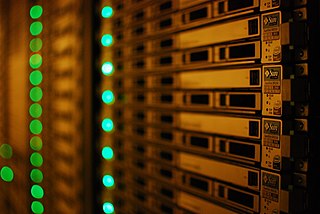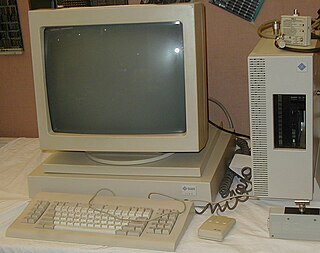
Athlon is the brand name applied to a series of x86-compatible microprocessors designed and manufactured by AMD. The original Athlon was the first seventh-generation x86 processor and the first desktop processor to reach speeds of one gigahertz (GHz). It made its debut as AMD's high-end processor brand on June 23, 1999. Over the years AMD has used the Athlon name with the 64-bit Athlon 64 architecture, the Athlon II, and Accelerated Processing Unit (APU) chips targeting the Socket AM1 desktop SoC architecture, and Socket AM4 Zen microarchitecture. The modern Zen-based Athlon with a Radeon Graphics processor was introduced in 2019 as AMD's highest-performance entry-level processor.

The Intel 386, originally released as 80386 and later renamed i386, is a 32-bit microprocessor introduced in 1985. The first versions had 275,000 transistors and were the central processing unit (CPU) of many workstations and high-end personal computers of the time.

The K6 microprocessor was launched by AMD in 1997. The main advantage of this particular microprocessor is that it was designed to fit into existing desktop designs for Pentium-branded CPUs. It was marketed as a product that could perform as well as its Intel Pentium II equivalent but at a significantly lower price. The K6 had a considerable impact on the PC market and presented Intel with serious competition.

Sun Microsystems, Inc. was an American technology company that sold computers, computer components, software, and information technology services and created the Java programming language, the Solaris operating system, ZFS, the Network File System (NFS), and SPARC microprocessors. Sun contributed significantly to the evolution of several key computing technologies, among them Unix, RISC processors, thin client computing, and virtualized computing. Notable Sun acquisitions include Cray Business Systems Division, Storagetek, and Innotek GmbH, creators of VirtualBox. Sun was founded on February 24, 1982. At its height, the Sun headquarters were in Santa Clara, California, on the former west campus of the Agnews Developmental Center.

Silicon Graphics, Inc. was an American high-performance computing manufacturer, producing computer hardware and software. Founded in Mountain View, California in November 1981 by James Clark, its initial market was 3D graphics computer workstations, but its products, strategies and market positions developed significantly over time.

The K6-2 is an x86 microprocessor introduced by AMD on May 28, 1998, and available in speeds ranging from 266 to 550 MHz. An enhancement of the original K6, the K6-2 introduced AMD's 3DNow! SIMD instruction set and an upgraded system-bus interface called Super Socket 7, which was backward compatible with older Socket 7 motherboards. It was manufactured using a 250 nanometer process, ran at 2.2 volts, and had 9.3 million transistors.

The K6-III was an x86 microprocessor line manufactured by AMD that launched on February 22, 1999. The launch consisted of both 400 and 450 MHz models and was based on the preceding K6-2 architecture. Its improved 256 KB on-chip L2 cache gave it significant improvements in system performance over its predecessor the K6-2. The K6-III was the last processor officially released for desktop Socket 7 systems, however later mobile K6-III+ and K6-2+ processors could be run unofficially in certain socket 7 motherboards if an updated BIOS was made available for a given board. The Pentium III processor from Intel launched 6 days later.

Xen is a free and open-source type-1 hypervisor, providing services that allow multiple computer operating systems to execute on the same computer hardware concurrently. It was originally developed by the University of Cambridge Computer Laboratory and is now being developed by the Linux Foundation with support from Intel, Citrix, Arm Ltd, Huawei, AWS, Alibaba Cloud, AMD, Bitdefender and epam.

The Athlon 64 X2 is the first native dual-core desktop central processing unit (CPU) designed by Advanced Micro Devices (AMD). It was designed from scratch as native dual-core by using an already multi-CPU enabled Athlon 64, joining it with another functional core on one die, and connecting both via a shared dual-channel memory controller/north bridge and additional control logic. The initial versions are based on the E stepping model of the Athlon 64 and, depending on the model, have either 512 or 1024 KB of L2 cache per core. The Athlon 64 X2 can decode instructions for Streaming SIMD Extensions 3 (SSE3), except those few specific to Intel's architecture. The first Athlon 64 X2 CPUs were released in May 2005, in the same month as Intel's first dual-core processor, the Pentium D.

Sun Fire is a series of server computers introduced in 2001 by Sun Microsystems. The Sun Fire branding coincided with the introduction of the UltraSPARC III processor, superseding the UltraSPARC II-based Sun Enterprise series. In 2003, Sun broadened the Sun Fire brand, introducing Sun Fire servers using the Intel Xeon processor. In 2004, these early Intel Xeon models were superseded by models powered by AMD Opteron processors. Also in 2004, Sun introduced Sun Fire servers powered by the UltraSPARC IV dual-core processor. In 2007, Sun again introduced Intel Xeon Sun Fire servers, while continuing to offer the AMD Opteron versions as well.

Cobalt Networks was a maker of low-cost Linux-based servers and server appliances based in Mountain View, California. The company had 1,900 end user customers in more than 70 countries.
Alchemy is a family of ultra low power embedded microprocessors originally designed by Alchemy Semiconductor for communication and media devices. Alchemy processors are SoCs integrating a CPU core, a memory controller, and a varying set of peripherals. All members of the family use the Au1 CPU core implementing the MIPS32 instruction set by MIPS Technologies.
The Cobalt RaQ is a 1U rackmount server product line developed by Cobalt Networks, Inc. featuring a modified Red Hat Linux operating system and a proprietary GUI for server management. The original RaQ systems were equipped with MIPS RM5230 or RM5231 CPUs but later models used AMD K6-2 chips and then eventually Intel Pentium III CPUs for the final models.

Sun-3 is a series of UNIX computer workstations and servers produced by Sun Microsystems, launched on September 9, 1985. The Sun-3 series are VMEbus-based systems similar to some of the earlier Sun-2 series, but using the Motorola 68020 microprocessor, in combination with the Motorola 68881 floating-point co-processor and a proprietary Sun MMU. Sun-3 systems were supported in SunOS versions 3.0 to 4.1.1_U1 and also have current support in NetBSD and Linux.

The R5000 is a 64-bit, bi-endian, superscalar, in-order execution 2-issue design microprocessor, that implements the MIPS IV instruction set architecture (ISA) developed by Quantum Effect Design (QED) in 1996. The project was funded by MIPS Technologies, Inc (MTI), also the licensor. MTI then licensed the design to Integrated Device Technology (IDT), NEC, NKK, and Toshiba. The R5000 succeeded the QED R4600 and R4700 as their flagship high-end embedded microprocessor. IDT marketed its version of the R5000 as the 79RV5000, NEC as VR5000, NKK as the NR5000, and Toshiba as the TX5000. The R5000 was sold to PMC-Sierra when the company acquired QED. Derivatives of the R5000 are still in production today for embedded systems.
Strongbolt is an operating system installation application based on the Linux operating system written by James McLoughlin. The Strongbolt operating system is specifically for Cobalt RaQ Appliance Servers. Sun Microsystems discontinued the popular Cobalt server appliances in 2004. Strongbolt was created in order to provide a new, actively developed operating system for these Server appliances. Strongbolt OS is a CentOS and BlueQuartz operating system installer for Cobalt RaQ and Cobalt Qube servers. The system installs similarly to the original Cobalt RaQ install disk. The new StrongBolt 2 release can also be installed from a USB key directly in the USB port. Strongbolt has been out of active development for several years.

SunPCi is a series of single-board computers with a connector that effectively allows a PC motherboard to be fitted in Sun Microsystems SPARC-based workstations based on the PCI architecture adding the capability for the workstation to act as a 'IBM PC compatible' computer. The Sun PCi cards included an x86 processor, RAM, expansion ports, and an onboard graphics controller, allowing a complete Wintel operating environment on a Solaris system. The SunPCi software running on Solaris emulates the disk drives that contain the PC filesystem. The PC software running on the embedded hardware is displayed in an X window on the host desktop; there is also a connector on the edge of the board that can optionally be used to connect a PC monitor.

The Ultra 1 is a family of Sun Microsystems workstations based on the 64-bit UltraSPARC microprocessor. It was the first model in the Ultra series of Sun computers, which succeeded the SPARCstation series. It launched in November 1995 alongside the MP-capable Ultra 2 and shipped with Solaris 2.5. It is capable of running other operating systems such as Linux and BSD.
The Sun Fire X4500 data server integrates server and storage technologies. It was announced in July, 2006 and is part of the Sun Fire server line from Sun Microsystems.
















